A quick video tour of the General Staff Black Powder Wargaming System. Not sure why, but the video does not capture ‘pop-up’ windows (that show unit strengths, positions, etc.).

A quick video tour of the General Staff Black Powder Wargaming System. Not sure why, but the video does not capture ‘pop-up’ windows (that show unit strengths, positions, etc.).
I‘m used to learning a lot when researching a battle but nothing prepared me for the ‘what ifs’ of Little Bighorn. My doctorate is in computer science but I have been an American Civil War buff since I was about five years old. I’m very familiar with brevet Major General George Armstrong Custer’s achievements during the Appomattox campaign where he commanded a division that smashed Pickett’s right flank at Five Forks. I knew that after the war Custer returned to his previous rank in the U. S. Army of Lt. Colonel, that he fell under a cloud with U. S. Grant, was stripped of his command, and had to beg for it back from President Grant, himself, at the White House.
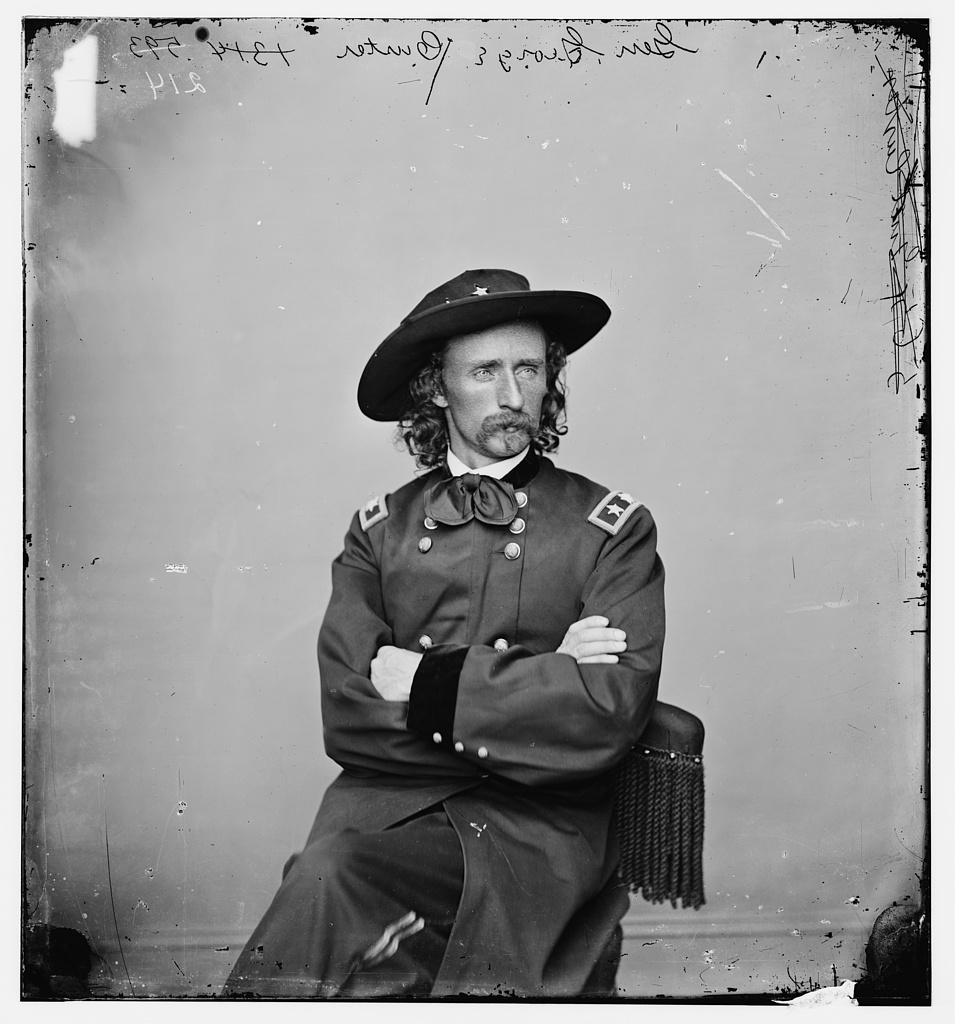
Brevet Major General George Armstrong Custer taken May 1865. Credit: Civil war photographs, 1861-1865, Library of Congress, Prints and Photographs Division. Click to enlarge.
And, of course, I knew of the debacle at the Little Bighorn.
After I wrote UMS, the first computer wargame construction system, users began to send me Little Bighorn scenarios that included Gatling guns. I assumed that these were science fiction ‘what if’ scenarios. such as a story I read back in the ’60s about what if Civil War units had automatic weapons from the future. But, recently, while reading Stephen Ambrose’s Crazy Horse and Custer I learned that General Alfred Terry, Custer’s superior and the commander of the expedition, had indeed offered Custer not just three Gatling Guns (manned by troops from the 20th Infantry 1)The Guns Custer Left Behind; Historynet
https://www.historynet.com/guns-custer-left-behind-burden.htm ) but four extra troops from the 2nd U. S. Cavalry. Custer turned down Terry’s offer of reinforcements and more firepower with these infamous words:
“The Seventh can handle anything it meets.” – Custer to Terry
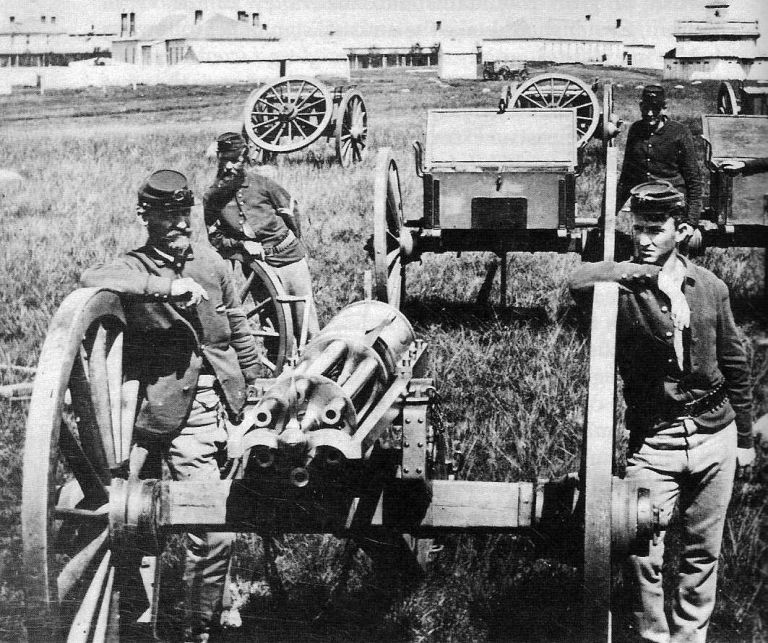
Photo taken by F. Jay Haynes of one of the Gatling guns that were available to the 7th Cavalry. Click to enlarge.
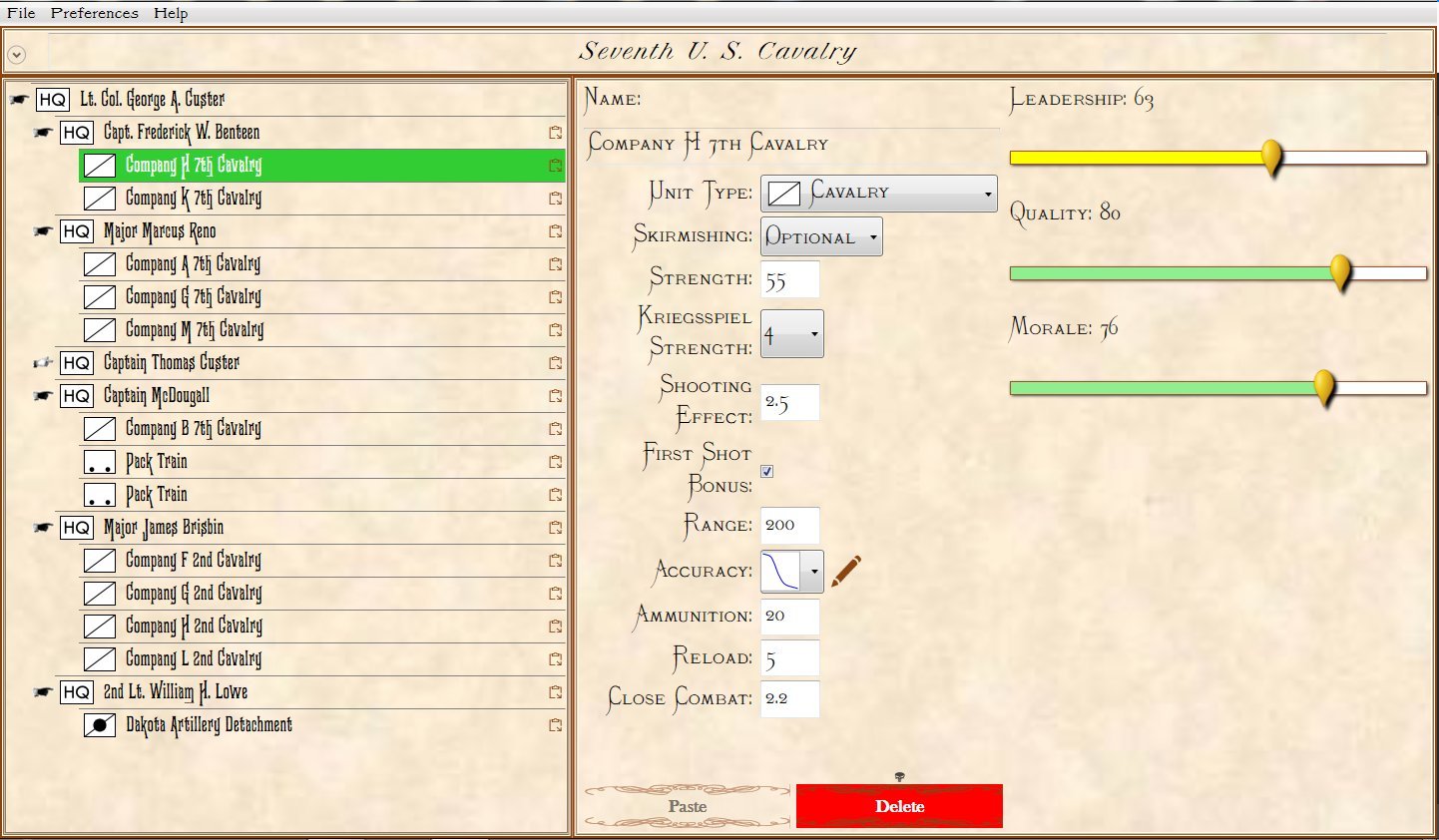
Screen capture of the Order of Battle of the 7th US Cavalry with the addition of 3 Gatling guns and 4 companies of the 2nd US Cavalry. Click to enlarge.
As for the battle of Little Bighorn, itself, I didn’t know much more than the broad outline that Custer and his command were killed to the last man by an overwhelming number of Native American warriors (this, of course, wasn’t correct as members of Reno’s and Benteen’s columns survived). Custer, himself, was the text book image of hubris and became the butt of late night comedians and humorous pop songs. But the reality turned out to be much more complex and nuanced.
Custer had a reputation of being dashing, headstrong, and gallant; the iconic description of a cavalry commander. The traditional narrative of the disastrous battle of Little Bighorn is that Custer impulsively attacked a vastly superior enemy force; possibly propelled by a belief that Native American warriors were no match for organized cavalry armed with 45-70 trap door carbines. Indeed, Napoleon’s maxim was that, “twenty or more European soldiers armed with the best weapons could take on fifty or even a hundred natives, because of European discipline, training and fire control.” 2)“Crazy Horse and Custer” p. 425 Stephen Ambrose To make matters worse, Custer had pushed the 7th mercilessly and by the time they arrived at the battlefield both men and horses were exhausted.
Custer’s plan of attack is also widely condemned as overly optimistic. He split his command of 616 officers and enlisted men of the 7th cavalry into three battalions. If the four companies of 2nd Cavalry had come along, Custer’s force would be 30% larger.3)Ibid The main force led by himself would be the right flanking column, Reno would have the left flanking attack column and Benteen and the pack train would be in the middle. Custer also drastically underestimated the Native American force at about 1,500.
In theory, Custer’s plan of attack wasn’t that bad:
Custer might have, indeed, had a great victory that would have propelled him to the US Presidency (as he had hoped). But none of these suppositions were correct.
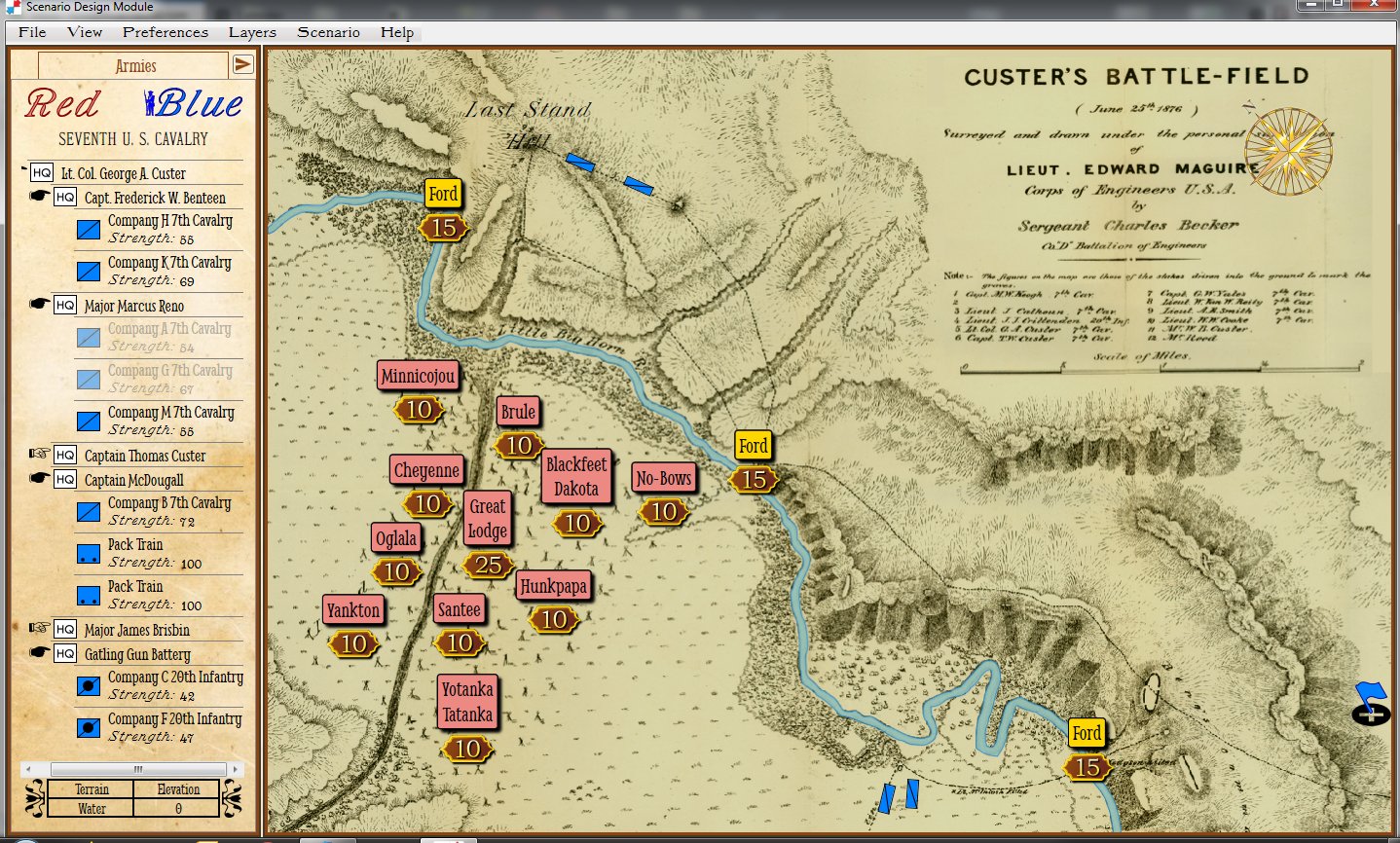
Screen shot of the General Staff Scenario Editor where the battle of Little Bighorn scenario is being set up. Not the Order of Battle of the 7th Cavalry (with attached units of the 2nd Cavalry and Gatling guns) on the left. Units are positioned by clicking and dragging them from the Order of Battle Table on the left onto the map. Click to enlarge.
So, the question remains: what value for Leadership would you give to Custer?

Screen shot of the General Staff Army Editor showing the slider that sets the Leadership value for a commander. What value would you give Custer? Click to enlarge
By the way, there will be three separate Little Bighorn scenarios for the General Staff Wargaming System: historically accurate Order of Battle for the 7th Cavalry, the 7th Cavalry plus four companies of the 2nd US Cavalry and 7th Cavalry plus four companies of the 2nd US Cavalry and 3 Gatling guns.
References
| ↑1 | The Guns Custer Left Behind; Historynet https://www.historynet.com/guns-custer-left-behind-burden.htm |
|---|---|
| ↑2 | “Crazy Horse and Custer” p. 425 Stephen Ambrose |
| ↑3 | Ibid |
There’s a joke in the movie, What’s Up Doc? that goes something like this; “So you’re a doctor of music are you? Can you fix a broken record player?” “No.” “Well, sit down then!” Yes, I really do have a doctorate in computer science but that hardly means I know everything about computers (just watch me trying to fix my wife’s old machine running Windows XP). The higher up you go on the academic ladder in computer science the more you deal with algorithms, optimization and ‘big ideas’ and the less you do with learning the latest Microsoft programming environment.
When I began programming General Staff two years ago I decided to write it in Microsoft WPF (Windows Programming Foundation). This ensures that the program will run as a ‘standard’ Windows program and there shouldn’t be any compatibility issues. Unfortunately, I had absolutely no experience with WPF but, as I’ve done all my life, I gamely plunged in and started learning as I went.
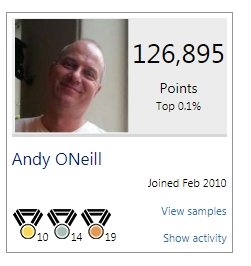 For the most part things went pretty well and when I ran into trouble there was the Microsoft Developer’s Forum to ask for help. However, about a month ago, I had really coded myself into a corner and when I asked for advice about how to straighten out the visual representation of an Order of Battle Table a very nice gentleman by the name of Andy O’Neill kindly stepped in, took a look at my code and explained that I was doing it all wrong.
For the most part things went pretty well and when I ran into trouble there was the Microsoft Developer’s Forum to ask for help. However, about a month ago, I had really coded myself into a corner and when I asked for advice about how to straighten out the visual representation of an Order of Battle Table a very nice gentleman by the name of Andy O’Neill kindly stepped in, took a look at my code and explained that I was doing it all wrong.
Andy is a superstar of the Microsoft Developer’s Forum. He is ranked in the top 0.1%, has 10 gold awards, 14 silver awards and 19 bronze awards. He was awarded the gold medal for the Microsoft Technical Guru in April 2015.
But, most importantly, Andy is a wargamer and knows what an Order of Battle Table is!
Andy lives in Liverpool, England just up the hill from Strawberry Fields and John Lennon’s house. While, professionally Andy is known for his work with business application development, data visualization (and, really, isn’t this what a wargame is?), point of sale chip and pin credit card integration and end consumer applications (especially GUI, or Graphical User Interface), it’s his interest in table top wargaming that makes him invaluable to the General Staff project.
Andy has been involved in table top wargaming since the ’70s and his main area of interest is 1/72 WW2 skirmishes but he’s also interested in Fantasy, Ancients, the Seven Years War, Ultra Modern, Monster Rampage, Darkest Africa and the Boer War. He also works on modifying rule sets.
Below are some of Andy’s incredibly detailed miniatures:
With Andy’s expertise we have made a number of important changes to the underlying data files used in General Staff. This will result in a much more robust Windows program. Furthermore, Andy has made some substantial contributions to the user interface making the entire process of creating armies and scenarios much more intuitive and user friendly.
I can’t thank Andy O’Neill enough for all his help.
We recently asked you for your favorite 18th and 19th century (‘Age of Gunpowder’) battles to be included free for early backers of General Staff (see this link). We don’t want to spoil any surprises, but the Battle of Isandlwana was one of the top vote-getters.
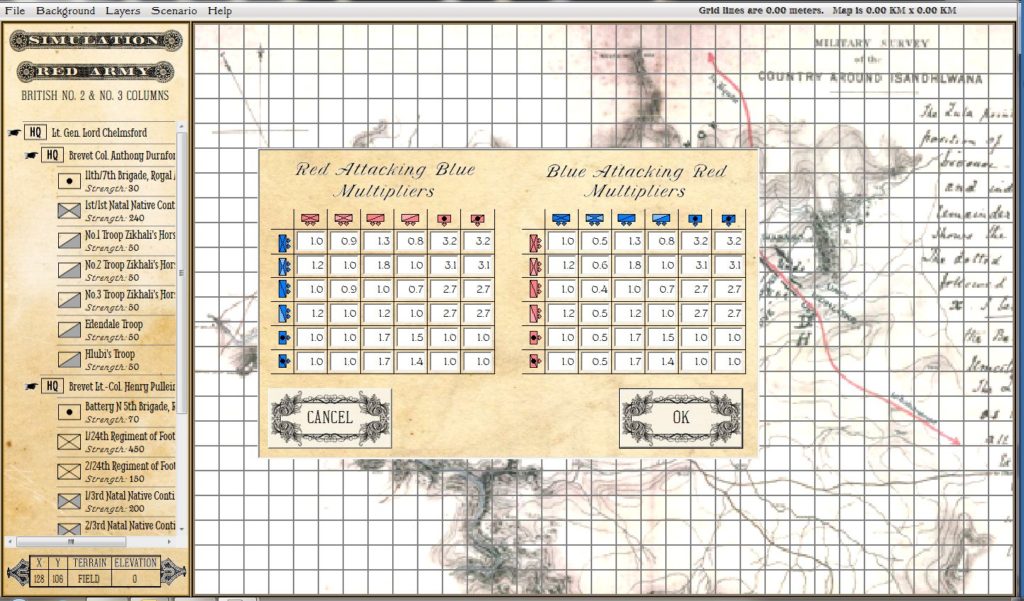
Screen shot of the General Staff Scenario Design Module showing how to edit specific unit type versus unit type combat equations. In this example Blue Light Infantry (Zulu regiments) have been adjusted downward. Click to enlarge.
The Battle of Isandlwana is an especially challenging scenario to simulate because of the difference in technology (the British were armed with Martini-Henry breech-loading rifles while the Zulu warriors carried the traditional assegai iron spears and cow-hide shields). Yet, there are ‘Light Infantry’ unit types in both the Red and Blue forces, but clearly there is a very big difference between the Red (British) Light Infantry and the Blue (Zulu) Light Infantry units.
General Staff, which is based on the UMS Wargaming System, has the ability to adjust a unit’s combat firepower versus other unit types (see the above screen capture). In the above image we have set Blue’s Light Infantry (Zulu regiments) with a lower Attack Multiplier representing the Zulu troops lack of muskets and rifles. This matrix is available from the General Staff Scenario Design Module.
In the above screen capture from the General Staff Army Design Module we see a portion of the British Order of Battle at Isandlwana. The question is: what should Leadership, Morale and Efficiency be set for each of these units? How good were British commanders? What was the morale of native troops? How efficient were they? We would love to hear your comments.
The General Staff Wargaming System provides users with the tools to create scenarios of their own design. These scenarios can be historical battles or they can be ‘what if’ scenarios (e.g. what if Custer had brought Gatling guns to the Little Big Horn or what if Robert E. Lee fought Wellington). To determine the victor of these scenarios or battles we need to have a predetermined set of Victory Conditions. Below is a screen shot of the Edit Scenario Victory Conditions screen:
And below is a screen shot of the self-checking error function for setting Victory Points:
The General Staff Wargaming System is designed to give maximum flexibility to the scenario designer. It fully supports creating scenarios from 18th and 19th century armies and any map.